Top 5 Tactical Shotguns for Home Defense

Shotguns are one of the most commonly available weapons around the world and Home Defense is a growing concern among many. With the increased uncertainty of the world and the many factors of Home Defense you really need a versatile weapon.
Shotguns are by far the most versatile guns on the planet. From barrel length to ammunition there is a shotgun out there for everyone. But not every shotgun is good for self-defense. Tactical shotguns are better designed to deal with threats in and around the home.
This leaves us with a few questions. What is a tactical shotgun? What is the best tactical shotgun? And more importantly, why should you use a tactical shotgun for home defense?
As with everything in the gun world, what is “the best” is up for debate. So, we will look at the top 5 Tactical Shotguns available today.
Top Tactical Shotgun Features
A semi-automatic or pump shotgun chambered in either 12 or 20 gauge is the basis of the tactical shotgun. The barrel will be between 18 and 20 inches for maneuverability and the shotgun will allow for the mounting of lights, sights, and accessories.
While many people think the shotgun is a simple universal tool, the reality is quite different. Shotguns tend to be more personalized to the end user, with Tactical Shotguns being on the far end of the personalized spectrum.
They are amazing tools but they are limited by a number of factors especially when compared to modern semi-automatic rifles. Let’s get into what makes a Tactical Shotgun and why it should be considered for Home Defense.
What is a Tactical Shotgun?
Tactical Shotguns differ from normal shotguns in a number of ways. These range from the length of pull (essentially how far you have to extend your arms when shouldering it), barrel length, sights, and ease of mounting accessories.
A tactical shotgun will be shorter than your average hunting shotgun. This means the barrel will be anywhere from 18 inches to 20 inches in length. This is to make them easier to use inside buildings while still being at or over the minimum legal barrel length.
Since accuracy is a major factor in home defense, tactical shotguns tend to have better sights than the average shotgun bead. Some tactical shotguns still use a bead sighting system, but many have rifle-like sights or the ability to mount more modern red dot sights.
Additionally, tactical shotguns will have the ability to mount flashlights, secondary sighting systems, and slings to them in order to increase your ability to use them in a wide variety of environments and light conditions.
Some of these modifications are aftermarket modifications and are not featured on the base models.
Why Should You Choose a Shotgun for Home Defense?
While many experts today will advocate for an AR-15 for home defense this is not always a viable option for many. Some people will say that only an AR-15 is good for home defense while others say a shotgun is the ideal.
The reality is that each individual’s situation will dictate what they should use. Legal restrictions, familiarity, and cost are all contributing factors when selecting a gun for home defense.
This might seem to indicate that a shotgun is sub-par for home defense and is only an option if you’re forced to use it. But this is far from true.
Shotguns are easier to control than a pistol. This is because they are larger and have more points of contact to help you hold onto the gun.
Shotguns are also more effective than a pistol because of the ammunition available to it. Shotguns are regularly used to take down medium sized game, which means they can easily take down people.
On top of this, the shotgun will either put more projectiles on your target per trigger pull or put a larger, heavier and more effective projectile on target.
But shotguns are not a “point and shoot” weapon like some people think. They still require skill to use. This is because they have different capabilities than modern semi-automatic rifles and have different handle requirements.
Let’s look at some factors that go into this.
Shotgun Factors: The How & Why of Shotgun Usage
Shotguns are simple in design, but very complex in use. This is because many of the design features of a shotgun have not changed in well over 100 years. They have been refined and optimized in some regards but aren’t on par with other more modern designs.
The shotgun has limitations. These limitations don’t make them a bad option, just one with more nuances. The nuances take the form of ammunition, capacity, and the action of a shotgun. Let’s go into greater detail.
Ammunition
All guns need ammunition, and shotguns have a wide variety of ammunition available to them. From minishells to magnum shells there is a shell for every task. Add in the different types of projectiles and you have a confusing set of options.
But what are the optimal choices for home defense?
Since home defense scenarios can occur within and around the home we cannot be too limited in our choices. This means we should have a shotgun in a common caliber for multiple reasons.
The first reason is availability. You might have a shotgun but if it is not in a common caliber like 12 gauge or 20 gauge you might not be able to find ammunition. This is especially important to consider during times of ammunition shortages, where availability is a major factor.
The second reason is that most ammunition refinements are found in 12 gauge or 20-gauge loadings. This means that you will be able to find ammunition designed for home defense or increased accuracy more easily than in a more exotic chambering.
While 12 gauge is considered the standard, 20 gauge offers a lighter recoil. This is a consideration for those who might have a smaller frame or are getting older. But for now we are going to use 12 gauge as our baseline.
The next ammunition consideration is the projectiles. We really have two options available to us: buckshot and slugs.
Buckshot and slugs are the main ammunition we should be using in our shotgun for home defense. Some will advocate birdshot, but this is not effective at as many ranges as buckshot will be. We don’t use birdshot on animals like deer, coyotes, or boars so we should not use them to defend ourselves from other people.
Buckshot comes in a variety of sizes but the minimum size we should use is #4 buck. This provides us with a large number of projectiles per shot, roughly 24 individual pellets. While this type of shot meets the FBI penetration requirement it does not produce the controllability and effectiveness of 00 buck.
The benefit of #4 buck is the increased hit probability but it has the drawback of putting more projectiles in the air. This makes it less ideal in a home defense scenario because we have to be sure of where our projectiles are going. We get that surety out of 00 buck.
The #4 would be useful in an outdoor area where we don’t have to worry about what’s behind or around our target. But for the average home defense situation, 00 buck should be our primary type of buckshot to use.
This is because of shotgun patterns. A shotgun pattern is the area where the pellets land consistently at certain distances and will vary from shotgun to shotgun. Patterning your shotgun, otherwise known as figuring out where your shotgun will put shot at various ranges, is extremely important in home defense.
You need to know where your shotgun will pattern at the distances you expect to use it. This will make the difference between putting all 9 of you 00 buck on target and putting half on target and the other half through an interior or exterior wall. Not knowing what that pattern looks like can result in accidentally injuring your family or neighbors.
The other option is to use a slug.
Slugs are single projectiles and come in a variety of designs that work with smoothbore or rifled shotgun barrels. Many people choose to use a smoothbore in order to take advantage of all the different ammunition available which means a Foster’s slug will be the primary slug type to use.
Slugs tend to be solid lead projectiles. This means that they will deform consistently when they hit a solid object. Combined with being only one projectile, this makes slugs ideal for near to medium distance engagements without having to worry about a broad shot pattern.
To get the most out of a slug, better sights like ghost ring sights or red dots are ideal. This will help make up for not having multiple projectiles per trigger pull that you would get with 00 buck. While 00 buck can be extremely accurate, especially with things like Federal Flight Control, slugs are more likely to be used in a shotgun when greater accuracy is required.
This does not mean we will be taking extremely long shots with our shotgun. For home defense we are looking at a maximum distance of 40 yards if not closer. While the effective range of a shotgun is 75 yards we are less likely to be able to control where our shots are going and have justification for lethal force at that range under normal circumstances.
This brings us to the next major nuance: capacity.
Capacity
The major drawback of a shotgun is capacity. Modern semi-auto rifles are spoiled with 20 to 30 round capacities as the standard while the shotgun usually has a capacity below 10 rounds.
While there are magazine fed shotguns, most shotguns are going to have a tubular magazine below the barrel. This limits the capacity of the shotgun to roughly 5+1 to 8+1 shells, or 5 to 8 shells in the magazine with one in the chamber.
This means when training with a shotgun you need to emphasize reloading. Keeping the shotgun as close to full capacity in a fight is harder to do than with a semi-auto rifle. It also means every shot will count more.
This is one of the reasons each shell needs to be extremely effective, because you have a very limited amount in comparison to other options.
Additionally, having extra ammunition attached to your shotgun will make it easier to reload and it keeps your home defense system all in one place. Keeping extra ammunition on the gun can be done with side saddles for the receiver and buttstock but better options today would be the use of a shot card.
Shot cards are semi-disposable side saddles that attack to the gun via Velcro©. This allows for empty shot cards to be easily replaced and easy installation of extra ammunition on the gun. This will keep you in the fight longer by doubling or even tripling the amount of ammunition available to you.
This is important because you might only have the ammunition attached to the gun available to you in a home defense situation. Going from only having at best 8+1 to 8+1 plus 7 reloads is a major advantage. The amount of extra ammunition depends on the size of the shot card and how many are placed on the shotgun itself. Usually this is one to two shot cards.
Solving our capacity problem brings us to the final factor: the action.
Semi-Auto or Pump: Shotgun Actions
The action of a shotgun is the method that ejects an empty shell and puts a new fresh shell in the chamber. In tactical shotguns this is going to be either a pump action or a semi-automatic action.
These two options introduce some interesting hurdles that you need to overcome if you are going to use a shotgun for home defense.
We are seeing a trend to use semi-automatic shotguns for home defense in preference to the tried and true pump action. This is because semi-automatic shotguns have less chance to experience a malfunction due to user error.
That user error is referred to as short stroking. This means you don’t pull the pump back far enough to chamber the next shell which at best does not chamber a shell and at worst causes the shotgun to jam.
Short stroking is more likely to occur under stress. This means you either have to take more time to train with a pump action under simulated stress or choose an option that removes that potential problem.
While pump shotguns are still a viable option, and are included in our top 5, a semi-automatic shotgun is preferable because they are easier to use and cannot be short stroked.
However semi-automatic shotguns do have a drawback in that quality versions tend to be rather expensive. They can range from $800 or more depending on the model but that extra price translates to reliability and generally more user friendly controls.
In comparison, a quality pump action can be anywhere from $400 to $800 depending on model and modifications. What this all comes down to is your budget, training, and preference.
Let’s get into how to use a tactical shotgun.
Tactical Shotgun Usage
Now that we understand some of the limitations of the shotgun let’s talk about how we use a shotgun. Tactical shotguns should have decent sights and a flashlight.
These are the bare minimum you need because they will help you with your accuracy and threat identification. The sights allow you to determine where you are aiming while the flashlight helps you determine what you are aiming at.
While traditional bead sights are not ideal they are better than no sights at all, however ghost ring sights are starting to become the standard base sighting system on newer shotguns. There are also kits and services that will allow you to change out your bead sight for a ghost ring.
The flashlight is the more important factor here. While a bead sight might be the bare minimum for aiming it doesn’t matter if you can’t see your target. We spend a large portion of our lives in areas with variable lighting conditions from complete darkness to dim lighting to bright light.
We are more likely to encounter an area with darkness or shadows than we are to encounter ideal lighting conditions. This means we have to bring our own light. Having a light on your tactical shotgun will allow you to positively identify your target and determine if they are a threat or not.
There are too many stories of someone accidentally killing a family member just because they could not identify what they were shooting at. A simple white light on your firearm will change that.
Make sure you know how to use your shotgun and flashlight at the same time. This will allow you to have better visual control over your environment while still being able to defend yourself.
Additional accessories to consider are improved sights (red dots), slings, and magazine extensions.
Red dot sights are easier to see and use than bead sights or more traditional iron sights. They allow for much faster aiming and are good for those who might have trouble with their eyesight.
The sling allows for you to be able to retain your shotgun while being able to use your hands. If you sling your shotgun it keeps it with you and it remains available should the situation change. Slings are not required for a home defense shotgun but they are extremely useful.
A magazine extension is rather self-explanatory. You will expand the ammunition capacity of the firearm and change the time between topping off the gun and running the gun empty. This is particularly useful on shotguns that are only sold with a 5+1 capacity but can be upgraded to more if your local laws allow you to.
With that in mind let’s look at five of our top options.
1. Beretta 1301
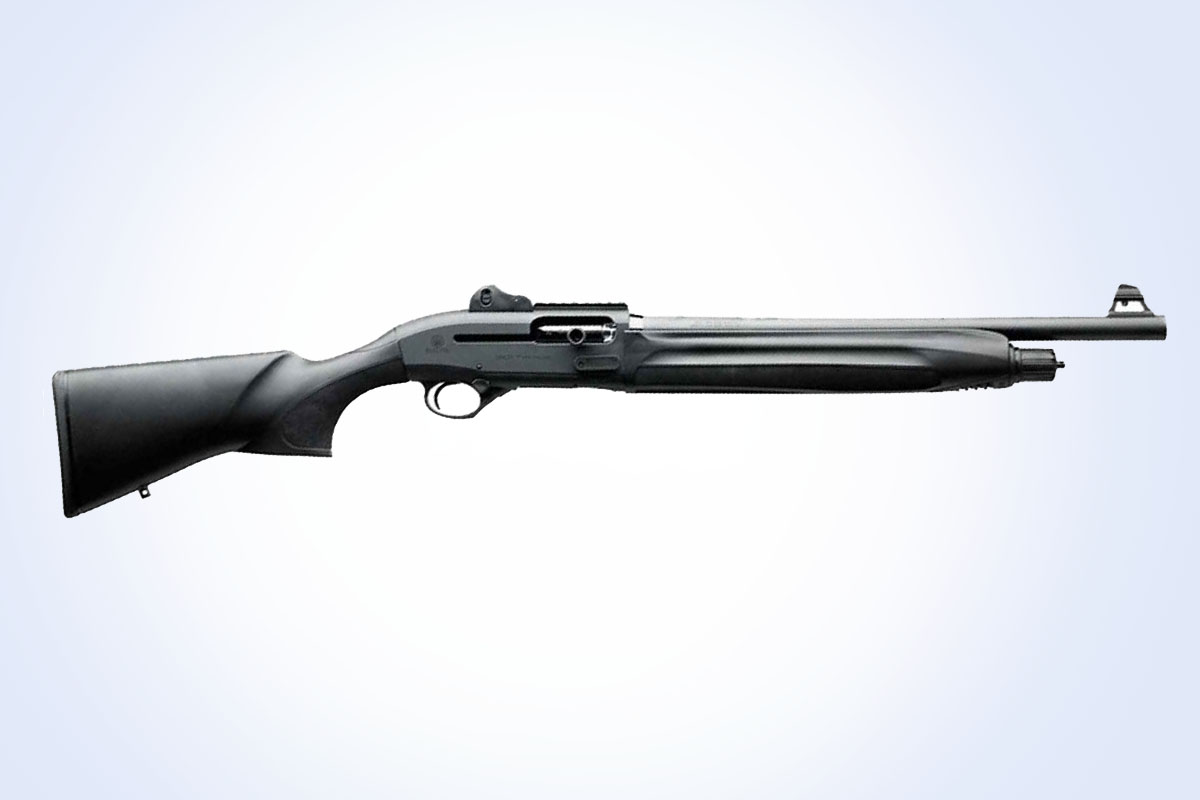
Beretta’s recent addition to the shotgun market is at the top of our list. It’s there for a number of reasons.
The first reason is that it is a semi-automatic 12 gauge that comes with ghost ring sights and an optic mounting rail right out of the box. While this model features the base capacity of 5+1 it can be outfitted with an extended tubular magazine which brings the capacity up to 7+1.
This means it can be used in areas that might have capacity restrictions or be legally modified to fit less restrictive locations.
It also has the end user in mind with easily used controls. The charging handle is oversized for better use. The bolt release is large and easy to use and the safety button is reversible to accommodate left handed shooters.
All these features are great since they make the gun easier to use under stress. One of the drawbacks is that it does not come with a pre fit light mount. While this is not hard to obtain, it will add cost and it means the 1301 is not already set up for home-defense when you buy it.
While on the higher side in price, the 1301 is actually cheaper than some other semi-auto models. So while it is more expensive than a pump, it is a more affordable semi-automatic.
Another benefit is the lighter weight. The Beretta 1301 is roughly 1 pound lighter than most of the other shotguns on this list. This helps with handling and it is better for smaller framed shooter without having to go to a 20 gauge option.
| Action | Semi-automatic |
| Capacity | 5+1 |
| Chambering | 12 Gauge, 3 inch |
| Sight | Ghost Ring |
| Accessories | Optics Rail mount |
| Weight | 6.4 lbs |
2. Benelli M4
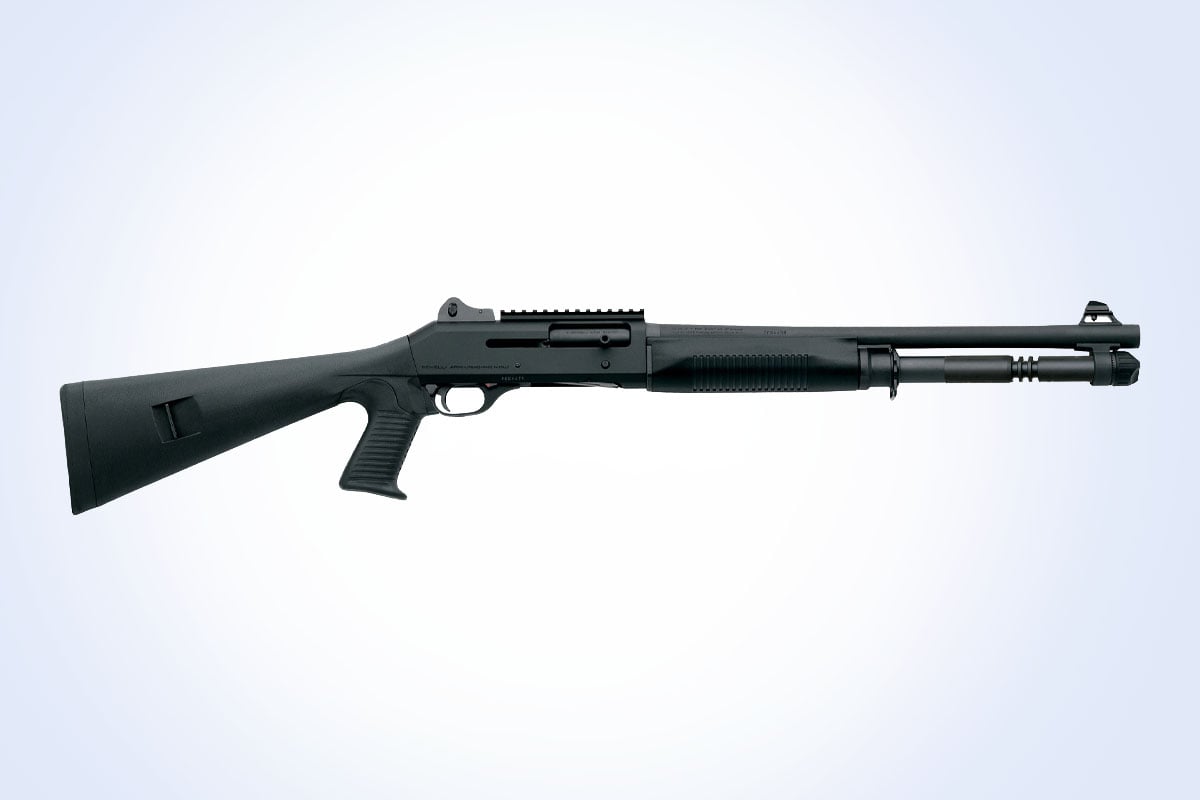
This tried and true semi-auto shotgun is most famously used by the Marine Corps. However this doesn’t mean that it is not good for home defense.
It features a pistol grip stock and side charging handle. It also features a ghost ring sight, optics mount, and it can be upgraded to a 7+1 capacity just like the 1301. But one thing it has that the 1301 does not is the ability to ghost load a shell.
This is a completely safe method to add an extra shell to the capacity of the shotgun. This is done by placing a shell in the chamber, then a shell in the loader which keeps the shell ready for use but in a limbo-like state. This means the base capacity of the Benelli M4 is technically 5+1+1.
This shotgun is definitely on the expensive side, but it has the advantage of having an extra round available without modification. It is also extremely durable and reliable. If you can afford it you should take it into consideration.
| Action | Semi-automatic |
| Capacity | 5+1 (+1 Ghost Load) |
| Chambering | 12 Gauge, 3 inch (Most Models) |
| Sight | Ghost Ring |
| Accessories | Optics Rail |
| Weight | 7.8 lbs |
3. Benelli Supernova
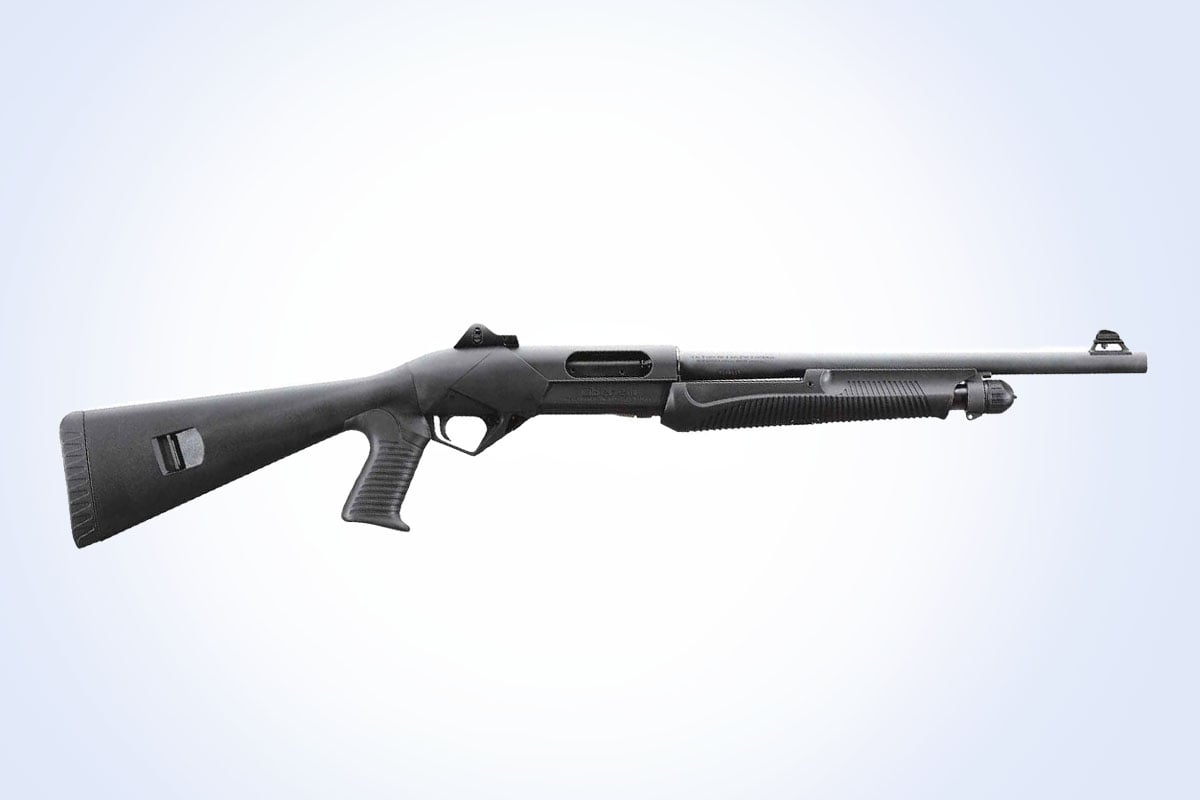
The first of our pump guns on the list, the Benelli Supernova comes in third mostly because of price. It is right in the middle of expense while still having a number of useful features.
It does not come with a light mount, but most of the shotguns on this list don’t feature a light mount as standard. It has a lower base capacity at 4+1 but it can accept up to 3 ½ inch shells which means it can have a wider variety of ammunition.
This is important if all you have available is larger 3 ½ shells compared to more common 3 inch shells.
The ghost ring sights come standard and there are magazine tube extensions. There are two types of stock available for this shotgun, the ComforTech recoil reduction system or a pistol grip stock.
A lot about this gun is average. The weight is within the average range, the sights are good, and it’s not too expensive. If you’re looking for something that will leave you a budget to upgrade it with, the Supernova might be the gun for you.
| Action | Pump |
| Capacity | 4+1 |
| Chambering | 12 Gauge, 3 ½ inch |
| Sight | Ghost ring, open rifle sights |
| Accessories | N/A |
| Weight | 7.6 lbs |
4. Mossberg 590 Tactical
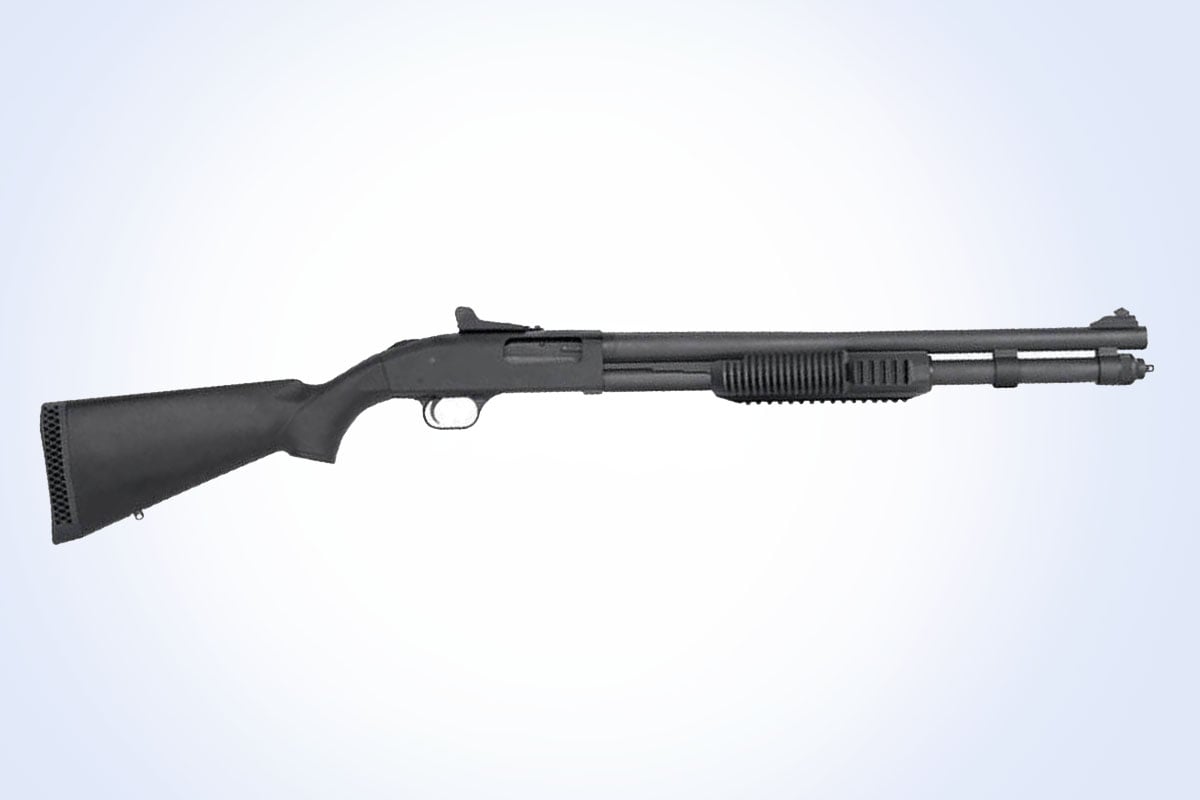
If you want a ready out of the box option, this Mossberg 590 is worth a look. While it features a longer barrel than most of the shotguns here at 20 inches, it allows for a base capacity of 8+1.
This shotgun requires the smallest amount of modification out of all the shotguns on this list. It comes with a good capacity, it has ghost ring sights already installed, and this variant even has a means to mount your light right away.
Some models will feature an M-LOK mounting system but this one has a Tri-Rail Forend ready to mount most of your Picatinny compatible lights.
While it does not come with the ability to mount a red dot like the 1301 and the Benelli M4, its base capacity and light-ready forend make it a great contender for your home defense shotgun.
The safety is ambidextrous which means there is one less thing that needs to be modified for a left handed shooter. The 590 isn’t expensive, but it’s on the more expensive side, especially for a pump action gun. But keep in mind it already comes with most of the upgrades you’ll have to get on the semi-autos anyway.
| Action | Pump |
| Capacity | 8+1 |
| Chambering | 12 Gauge, 3 inch |
| Sight | Ghost Ring |
| Accessories | Tri-rail Forend, M-Lok (model dependent) |
| Weight | 7.25 lbs |
5. Remington 870 Express Tactical
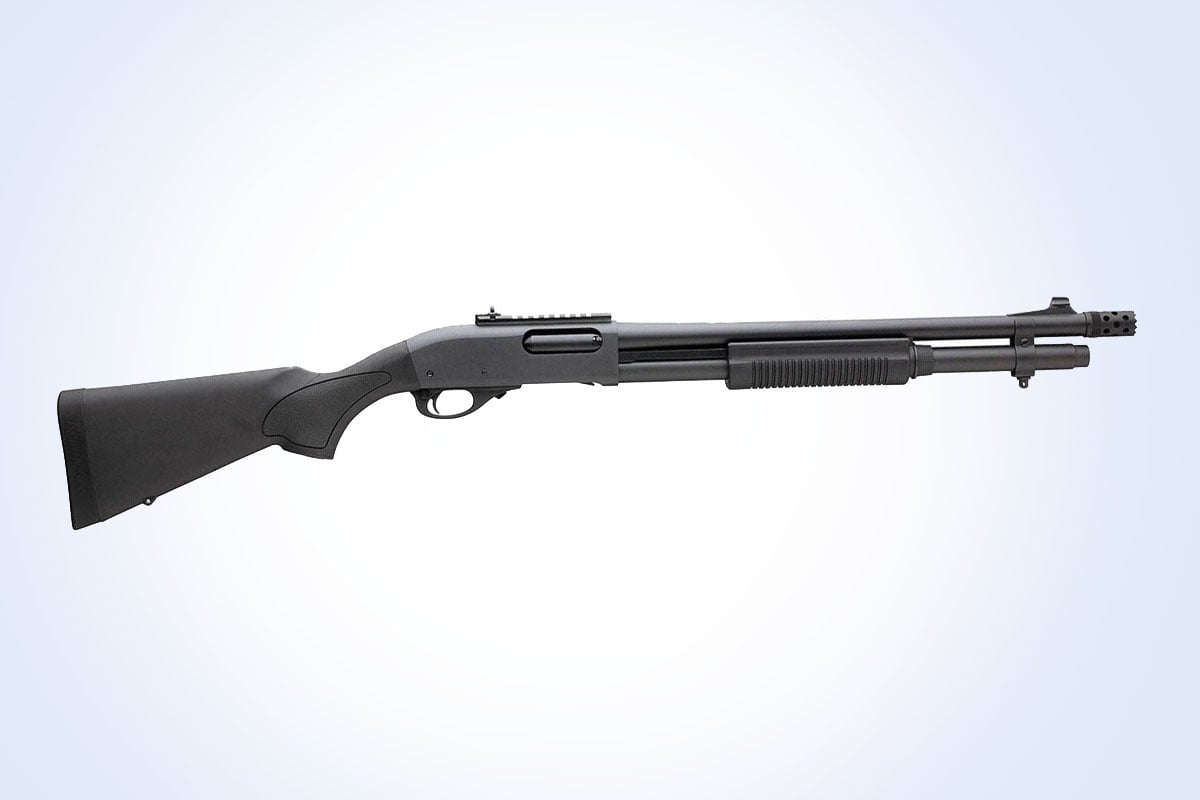
This more traditional shotgun is great if you want a more universal tool. It doesn’t feature a lot of upgrades but the price is good.
The Remington 870 Express features synthetic furniture, a bead front sight, and a 6+1 capacity. With the cross-bolt safety and dual arm pump, this shotgun is more of an updated version of an old classic.
This makes it perfect for long-time shotgun users who don’t want to spend a lot on a newer shotgun, but have developed the skills to use things like the bead sight effectively.
An added benefit is that it doesn’t look as tactical as other models do. It would fit right in with other hunting shotguns but with the added benefits of home defense.
This is a good option. It’s not amazing but you’ll get a reliable system that can fill multiple roles without breaking the bank.
| Action | Pump |
| Capacity | 6+1 |
| Chambering | 12 Gauge, 3 inch |
| Sight | Single Bead |
| Accessories | N/A |
| Weight | 7.5 lbs |
Conclusion
There are numerous other shotgun models and styles that people will think are better than this list. That’s just the nature of things. However this list is more of a rough guide to help you determine what you should look for in a home defense tactical shotgun.
Some of these options might be exactly what you’re looking for or they might have some features that you like, but don’t find in these particular models.
Always train with the tool you’re going to use for home defense. You might find out that what you thought you needed was not the right tool for the job. Either way, you’ll find out just how your shotgun will perform so you can be sure of its performance when you need it most.